Collaborative Green Infrastructure Design Group F: Difference between revisions
No edit summary |
|||
| (One intermediate revision by the same user not shown) | |||
| Line 117: | Line 117: | ||
== What are the overall objectives of your design? What are the specific objectives for enhancing green infrastrucutre? == | == What are the overall objectives of your design? What are the specific objectives for enhancing green infrastrucutre? == | ||
The objectives of the design are focused on revitalizing the Darsena area by proposing interventions for the water body itself with its surrounding area and can be classified into 2 categories; short and long term. The short term objectives are focused on emphasizing the historical value of the Darsena especially the Historic Spanish Wall. They also aim to enhance the surrounding area which is currently in a degraded condition and is not connected successfully to the water body. In addition, a larger scope is considered for the short term development which involves connecting Darsena to other green areas in the proximity. | The objectives of the design are focused on revitalizing the Darsena area by proposing interventions for the water body itself with its surrounding area and can be classified into 2 categories; short and long term. The short term objectives are focused on emphasizing the historical value of the Darsena especially the Historic Spanish Wall. They also aim to enhance the surrounding area which is currently in a degraded condition and is not connected successfully to the water body. In addition, a larger scope is considered for the short term development which involves connecting Darsena to other green areas in the proximity. For the long-term, a futuristic solution for vehicular traffic is envisioned by channeling vehicular traffic to underground roads thus leaving the open-air paths as pedestrian zones. Another vision involves reopening the old canals and reconnecting the Darsena Basin to the Naviglio della Martesana, which means that the water network in Milan will be connected to Lake Como and Lake Maggiore. | ||
== Analytical drawings == | == Analytical drawings == | ||
<gallery caption="Analytical Drawings " widths=" | <gallery caption="Analytical Drawings " widths="300px" heights="250px" perrow="3"> | ||
Image:Uses_Darsena.jpg|'''Building Uses Analysis''' (Reused from Assignment Three) | Image:Uses_Darsena.jpg|'''Building Uses Analysis''' (Reused from Assignment Three) | ||
Image:Transportation_Darsena.jpg|'''Transportation Analysis''' (Reused from Assignment Three) | Image:Transportation_Darsena.jpg|'''Transportation Analysis''' (Reused from Assignment Three) | ||
| Line 132: | Line 132: | ||
After coming up with the objectives, each group member has worked on a projective drawing depicting one aspect. | After coming up with the objectives, each group member has worked on a projective drawing depicting one aspect. | ||
<gallery caption="Projective Drawings " widths=" | <gallery caption="Projective Drawings " widths="300px" heights="300px" perrow="3"> | ||
Image:Vertical_Interventions_Darsena.jpg|'''"Greening" the Immediate Surroundings of the Basin''' (Maroula) | Image:Vertical_Interventions_Darsena.jpg|'''"Greening" the Immediate Surroundings of the Basin''' (Maroula) | ||
Image:Short_Term_Pedestrian_Intervention_copy.jpg|'''Short-Term Pedestrian Interventions in the Surrounding Streets''' (Maroula) | Image:Short_Term_Pedestrian_Intervention_copy.jpg|'''Short-Term Pedestrian Interventions in the Surrounding Streets''' (Maroula) | ||
| Line 138: | Line 138: | ||
Image:J1.jpg|'''Connectivity of Green Spaces Surrounding Darsena Area Policies, Creating Pedestrian Routes ''' (Maliheh) | Image:J1.jpg|'''Connectivity of Green Spaces Surrounding Darsena Area Policies, Creating Pedestrian Routes ''' (Maliheh) | ||
Image:J2.jpg|'''Connectivity of Green Spaces Surrounding Darsena Area Policies, Long-Term Vision of Underground Streets ''' (Maliheh) | Image:J2.jpg|'''Connectivity of Green Spaces Surrounding Darsena Area Policies, Long-Term Vision of Underground Streets ''' (Maliheh) | ||
Image:Darsena_Long_Term.jpg| '''Long Term Projection - Reopening of the old city canals | Image:Darsena_Long_Term.jpg| '''Long Term Projection - Reopening of the old city canals''' (Elena) | ||
</gallery> | </gallery> | ||
== Design Synthesis == | == Design Synthesis == | ||
<gallery caption="Design Synthesis Drawings" widths=" | <gallery caption="Design Synthesis Drawings" widths="300px" heights="300px" perrow="3"> | ||
Image:Projections.jpg|Synthesis Map | Image:Projections.jpg|Synthesis Map | ||
Image: | Image:Design_Visualization_Darsena.jpg|Sketch | ||
Image: | Image:SWOT_Darsena.jpg|SWOT Analysis | ||
</gallery> | </gallery> | ||
== Summary of the collaborative process == | == Summary of the collaborative process == | ||
Working in a group with international members has been an interesting experience. Elena, who is most familiar with the case, provided us with the information needed in order to comprehend the current situation. She also provided us with additional information that we needed during the process since most references were Italian. All members of the group have interacted fully during all stages of the project and the vision for the site was conceived together which is why the projective drawings each focus on one theme of the holistic vision we have for the area. Since the members of the group come from similar backgrounds it was easy to communicate the ideas within the group. Fortunately , there were no conflicts of interests and therefore the design process flowed smoothly. Overall, it was a collaborative effort in which each member brought in different ideas and presented the drawings in her own unique style of representation. | |||
== Image Gallery == | == Image Gallery == | ||
Latest revision as of 15:09, 25 January 2015
---> back to group page working group F
Collaborative design for implementing Green Infrastructure in the Darsena Area - Milan (Italy)
| Name | The Darsena Area | |
| Location | Milan | |
| Country | Italy | |
| Authors | Maliheh Shahghadami, Maroula Shami, Elena Staffoni, Andreea Webb | |
![[1]](/images/thumb/7/7e/Darsena_main.jpg/300px-Darsena_main.jpg)
| ||
|
| ||
Landscape and/or urban context of your case
Biogeography
Milan normally experiences a Mediterranean climate with wet and cold winters, and humid and hot summers. Metropolitan cities experience a 2-3 degree higher rise in temperature than rural areas due to the urban heat island effect. In Milan people may experience an average temperature of +4 degree Celsius to +6 degree Celsius in January, which could heat up to 15-28 degree Celsius in July. Snowfalls, a common occurence in Milan, has decreased in the last 15-20 years due to the effects of Global Warming. The average snowfall during winter could range between 30 to 40 cm. The greatest snowfall ever was recorded in January 1985 which was about 100 cm. The city’s climate which was mainly distinguished by its fog, due to the Po Basin effect has reduced considerably in the recent years due to lessened pollution and global warming. Milan is snuggled up in the lower plains of the Padana in the west-central Lombardy region of Italy. The rivers of Ticino, Po and Adda are an integral part of Milan’s province which is the first releases of the alpines. Milan occupied a total area of 181 sq.kms with a sea level rise of 122 m. The Milan city and metropolitan areas form the core industrial principal towns in Italy.
Cultural features
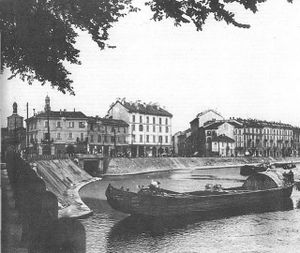
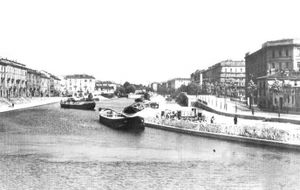
The Inner Circle of canals (Navigli) was a circular channel of about 6.5 km that, up to the 20's of the twentieth century, surrounded the center of Milan. The canal system was about 9 meters wide and was equipped with navigation locks and port areas of which the most famous was the Lake of Santo Stefano behind the Duomo (covered in 1857). Along the way there were 30 more little canals that were used to irrigate the orchards citizens and nurture important mills. The name of places today is recorded by the ancient urban design; The street over the Santo Stefano lake is today called Via Laghetto (Lake Street) and the street over the mills' little canal is called Via Molino delle Armi (Mills Street). The route of the canals' ring resumed the ancient moat of medieval Milan, dug in 1167, and corresponded to the current streets Fatebenefratelli, Senato, San Damiano, Visconti Modrone , Francesco Sforza , Santa Sofia , Molino delle Armi, De Amicis , Carducci , Piazza Castello and via Pontaccio. At the end of the '300 the moat, expanded and made navigable, takes the name of "Cerchia Interna dei Navigli" (Inner Circle of Navigli) and it was used for the transport of marble Candoglia to the construction of the Duomo. In 1496 the ring of canals was connected to the Martesana Canal through the basins of Incoronata and S. Marco, making it the center of the system of the canals of the Lombardy Region, allowing continuous navigation from the Adda river to the Ticino river. This important function was to decline in 1929 when the Inner Circle was entirely covered.
Cultural curiosity
- The canals were a symbol of romance that the Futurists hated. Even today in Corso Venezia number 23 you can read a license plate that says: "That's the house where in 1905 Filippo Tommaso Marinetti founded the magazine Poetry. Hence the Futurist movement launched his challenge in the moonlight mirrored in the canal".
- The Navigli and the Darsena were the subject of many paintings especially in 19th Century.
- In the middle of XV Century, Leonardo da Vinci realised a system of locks (devices for raising and lowering boats between stretches of water of different levels on river and canal waterways) for the Navigli.
Overall character
The history of Milan is closely connected with the creation of the Navigli, which pass as water network the whole city. Milan does not have a direct river connection. To ensure the water supply and to create transport routes, just in the antique ages was begun with the construction of artificial waterways, fed by the rivers of the hinterland (Ticino, Lambro, Adda). Thanks to the connection of artificial waterways from the rivers Ticino and Adda towards the Po River, Milan is practically connected to the Adriatic Sea. On the banks of the Naviglio formerly lived workers and artisans. Today, the area of the Naviglio could be a romantic area with artists' studios, original shops, romantic pubs, flea markets, and summer concerts but this atmosphere is unfortunately no more present.Outside Milan the water network serves for the irrigation of the fertile Padana fields Po Valley (the Europe’s largest plane extended from Milan to the hills). On the configuration of the locks of the channels already worked Leonardo da Vinci.
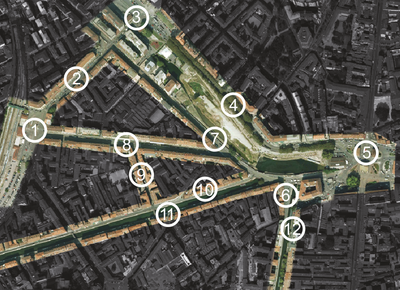
Naviglio Grande
The oldest canal was built in the years 1177-1257 and is fed by the river Ticino. The Naviglio Grande is about 50 km long, and served as an export and import route. For the transport of the enormous marble blocks from the reservoirs at Candoglia on Lake Maggiore, which were needed for the construction of the Milan Cathedral, the Naviglio was extended up to the cathedral. At the time of the construction of the cathedral, the waterway was conducted into the city center. The street name Via Laghetto (road by the pond) behind the cathedral testifies that. Today this part of the Naviglio was filled. Along the Naviglio Grande towards Ticino you will find the villages Cesano Boscone, Assago, Buccinasco, Corsico, Trezzano sul Naviglio, Gaggiano, Vermezzo und Abbiategrasso, that use the waters of the Naviglio for agriculture. Typical are the old houses and wash houses with wooden roofs and craftsman houses that that remember past times. Today they house cafes and restaurants behind the typical facades and provide an ideal atmosphere for the evening meeting for the Milan's youth.
Naviglio Pavese
Naviglio Grande and Naviglio Pavese meet in the old harbor, the Darsena. Built in the 14th century, here is the connection between Naviglio Grande and the 35 km long Naviglio Pavese, which continues to flows about Binasco and Pavia to the river Po and the Adriatic Sea. An old sluice called "Conchetta" was set in motion again at the Naviglio Pavese. The special feature of the sluice is the hydraulic mechanism that Leonardo da Vinci invented to facilitate the opening of the locks. Thanks to a simulation, the invention of Leonardo was made visible again.
Darsena - the Harbor
The port Darsena was built in 1603 as a trade hub and is the main link between the Navigli. The Naviglio Grande is flowing into the Darsena while Naviglio Pavese and Ticinello are flowing out. Along the Darsena there is a weekly market held on Saturdays, where mainly second-hand goods and antiques are offered. The boat trip on the Canal Naviglio takes about one hour. It starts on the Naviglio Grande, pass the houses of the historic Milan and arrives the old bridges in the former harbor Darsena to continue the Naviglio Pavese to the lock where, thanks to the simulation, the inventions of Leonardo da Vinci are to be admired.
Naviglio della Martesana
The Naviglio della Martesana gets its water from the river Adda, which is powered from the side arm of Lake Como, the Lago di Lecco. The Naviglio della Martesana flow through the towns of Gorgonzola and Cernusco sul Naviglio and disappears in the center of Milan Garibaldi. Along the Naviglio della Martesana leads a popular cycle route from Milan to the river Adda. There the cycle way continues to north along the river Adda to Lecco.
History and dynamics
- History of the Navigli waterways in the Regional Scale
XII Century [5]
XIII Century [6]
1457 A.D. [7]
XVIII Century [8]
XX Century [9]
The city of Milan is at the center of a territory in between the rivers Ticino and Adda, large water ways that descend from the lakes Maggiore and Como. Unlike most thriving cities, Milan is not served by a major river. The construction of the artificial canal system started off with the outlining of the Naviglio Grande in 1179, linking Lake Maggiore of the Italian Alps with the region of Lombardia and the city of Milan via the Ticino River. Eventually, this complex water system was connected to the other major Northern Italian rivers Lambro, Adda, and the Po, which ultimately feeds into the Adriatic Sea. The Naviglio Grande was ingeniously developed to maximize natural rainfall, springs, and to drain marsh and swamp lands, as well as to irrigate former wasteland. The idea was also to connect the different cities that belonged to Milan, Abbiategrasso, Turbigo, Tornavento, Vizzola and others.The Naviglio Grande is often called 'il Ticinello', or the Little Ticino, because its water is drawn from the Ticino River. It connects Lake Maggiore, from the city of Sesto Calende, to the city of Milan. The watersystem became fully navigable in 1272 after an improvement of the canal making it wider and deeper. The Naviglio Grande made the movement of important items of commerce possible: grain, alt, wine, manufactured goods, coal, timber, livestock, cheese, hay, etc. The Naviglio Grande was used for troop and defense movement as well. The granite and marble used in the construction of the Dome of Milan was transported on the Naviglio Grande from the Alps. The canal did served as an irrigation system and as a mean of transportation, and also gave the population the possibility to fish and bathe in the water. The canal contributed to an improved health of the region, vegetation and crops in the newly irrigated farmland began to grow. The costruction of Naviglio grande was followed by the Naviglio Pavese and Naviglio Martesana and these three canals were all connected through Milan via the Fossa Interna, also known as the Inner Ring. The urban section of the Naviglio Martesana was covered over in the beginning of the 1930s, together with the entire Inner Ring. Commercial carrying continued on the Naviglio Grande, but the decline was steady and by the sixties it was over for good. During the 18th and 19th C impressive villas and palaces with lush gardens were built along the canals. The elite of Milan constructed summer houses here, most of which still stand today. Today one can embark on tours of the Naviglio from Milan. The activity is intense along the Naviglio, especially on weekends. Fishing, hiking, biking, and walking are popular treats this beautiful environment offers.
- Illustrations
The Darsena empty basin[10]
The Darsena in the 60s[11]
People on the Naviglio enjoying an Aperitivo [12]
Potentials and conflicts
The POTENTIALS of the site are many. The area has some potentials physical ELEMENTS that are the water basin with its dried part to be redesigned, the water canals that connect the city with the surrounding region and the Piazzas, in particular the Piazza XIV Maggio, a space with historical value that needs to be redeveloped. Another important potential is the LOCATION of the site, in the middle of the city. The place is very often frequented by people, especially during the night; the inhabitants love this place. The third potential is that the place is linked to the HISTORY because the Navigli and the Darsena in the past were fundamental for the transportation of people and goods; "The marble blocks were transported from Candoglia to Milan by means of the waterways from the river Toce to Lake Maggiore, along the Ticino and the Naviglio Grande canal and then into the city as far as the darsena [dock] of S. Eustorgio. Via the system of locks, created by Veneranda Fabbrica, the marble arrived at Laghetto, now Via Laghetto, only a few hundred metres from the Cathedral construction site" [13]. See the image above for a visual idea.
The CONFLICTS of the site are mainly identifiable in Urban conflicts:
- Too many private auto traffic, even though the area is well served by transportation and the related "wild parking".
- Lack of space due to the presence of (historic) buildings that are to preserve.
- Scarcity of green areas due to the compact fabric of the city.
- Presence of archaeological ruins (founded during some excavation; the discovery stopped the redevelopment works).
and Social conflicts:
- Social and cultural conflict between frequenters of the pubs on the Navigli (mainly responsible of the illegally parking, of the night long noise and of the dirtiness). The place have lost its original character, the little artisan atelier are today displaced by bars and pubs.
- Economic and bureaucratic problem stopped many time the redevelopment works.
What are the overall objectives of your design? What are the specific objectives for enhancing green infrastrucutre?
The objectives of the design are focused on revitalizing the Darsena area by proposing interventions for the water body itself with its surrounding area and can be classified into 2 categories; short and long term. The short term objectives are focused on emphasizing the historical value of the Darsena especially the Historic Spanish Wall. They also aim to enhance the surrounding area which is currently in a degraded condition and is not connected successfully to the water body. In addition, a larger scope is considered for the short term development which involves connecting Darsena to other green areas in the proximity. For the long-term, a futuristic solution for vehicular traffic is envisioned by channeling vehicular traffic to underground roads thus leaving the open-air paths as pedestrian zones. Another vision involves reopening the old canals and reconnecting the Darsena Basin to the Naviglio della Martesana, which means that the water network in Milan will be connected to Lake Como and Lake Maggiore.
Analytical drawings
- Analytical Drawings
Projective drawings
After coming up with the objectives, each group member has worked on a projective drawing depicting one aspect.
- Projective Drawings
Design Synthesis
- Design Synthesis Drawings
Summary of the collaborative process
Working in a group with international members has been an interesting experience. Elena, who is most familiar with the case, provided us with the information needed in order to comprehend the current situation. She also provided us with additional information that we needed during the process since most references were Italian. All members of the group have interacted fully during all stages of the project and the vision for the site was conceived together which is why the projective drawings each focus on one theme of the holistic vision we have for the area. Since the members of the group come from similar backgrounds it was easy to communicate the ideas within the group. Fortunately , there were no conflicts of interests and therefore the design process flowed smoothly. Overall, it was a collaborative effort in which each member brought in different ideas and presented the drawings in her own unique style of representation.
Image Gallery
- Image Gallery
A. Inganni (1835) Milano, a City Water [14]
I.Karpoff, Naviglio d'Inverno [15]
Canals covering [16]
Boat tour at the end of XIX Century [17]
Summer Aperitivo on Navigli side [18]
Naviglio Grande [19]
Naviglio Grande evening [20]
Graffiti on a building in the Darsena area [21]
sunday flea markt [22]
Naviglio Martesana [23]
The Naviglio Grande in Gaggiano town [24]
Swimming competition in Naviglio Grande [25]
The oldest representation of the city (XIV Century) [26]
Green area system map of the Milan province [27]
Lombardy waterways [28]
Waterways map for the EXPO 2015 [29]
References
- ↑ <http://www.scattiesguardi.net/foto/alba_mi/darsena5175_800.jpg>
- ↑ <https://www.google.it/search?q=darsena+anni+60&client=ubuntu&hs=fF9&channel=fs&source=lnms&tbm=isch&sa=X&ei=Vtl4VKLJB8XwaN-MgrAF&ved=0CAgQ_AUoAQ&biw=1600&bih=722#channel=fs&tbm=isch&q=darsena+1912&facrc=_&imgdii=_&imgrc=P0lwYvNUcr3PwM%253A%3BrHWt9XSeuLLMrM%3Bhttps%253A%252F%252Ffarm7.staticflickr.com%252F6035%252F6328442023_25e6631a10_m.jpg%3Bhttps%253A%252F%252Fwww.flickr.com%252Fphotos%252Fmilan_lera_insc%252F6927394602%252Fnearby%252F%253Fby%253Downer%2526taken%253Dalltime%2526sort%253Ddistance%2526show%253Ddetail%2526page%253D2%3B1000%3B843>
- ↑ <http://www.milanoneltempo.it/darsena.html>
- ↑ Re-elaborated version of a Google Maps image, Darsena Area.
- ↑ Map of artificial channels system (Navigli) in Milan and Pavia province during XII century. In blue artificial channels built for irrigation purpose, 1989, Regione Lombardia.
- ↑ Map of artificial channels system (Navigli) in Milan and Pavia province during XII century. In blue artificial channels built for irrigation purpose, 1989, Regione Lombardia.
- ↑ Map of artificial channels system (Navigli) in Milan and Pavia province during XII century. In blue artificial channels built for irrigation purpose, 1989, Regione Lombardia.
- ↑ Map of artificial channels system (Navigli) in Milan and Pavia province during XII century. In blue artificial channels built for irrigation purpose, 1989, Regione Lombardia.
- ↑ Map of artificial channels system (Navigli) in Milan and Pavia province during XII century. In blue artificial channels built for irrigation purpose, 1989, Regione Lombardia.
- ↑ La Repubblica-Milano.it<http://milano.repubblica.it/cronaca/2013/01/23/news/la_darsena_dice_addio_all_oasi_via_libera_al_taglio_degli_alberi-51088980/>.
- ↑ Navigli live -Milano <http://www.naviglilive.it/immagini%20associazione%20naviglilive/tavole%20darsena%20parcheggio/Nuova%20cartella/darsena%20milano%20navigli%2014.jpg>.
- ↑ Corriere della sera DOVE <http://viaggi.corriere.it/viaggi/weekend/citta/2013/luglio/italia-low-cost-nightlife.shtml>.
- ↑ <http://www.duomomilano.it/en/infopage/the-candoglia-quarries/47190562-c3f4-4196-8889-729729f4e54c/>
- ↑ <https://www.google.it/search?q=a+inganni+navigli&client=ubuntu&hs=wi1&channel=fs&source=lnms&tbm=isch&sa=X&ei=rft1VOmnK4T6ywPcj4HgDQ&ved=0CAkQ_AUoAg&biw=1600&bih=686#facrc=_&imgdii=_&imgrc=dTjE9w3MoYgciM%253A%3BLw4SC5MBcYXegM%3Bhttp%253A%252F%252Fupload.wikimedia.org%252Fwikipedia%252Fcommons%252F4%252F43%252FAngelo_Inganni%252C_Veduta_del_Naviglio_e_della_chiesa_di_San_Marco_in_Milano.jpg%3Bhttp%253A%252F%252Fcommons.wikimedia.org%252Fwiki%252FFile%253AAngelo_Inganni%252C_Veduta_del_Naviglio_e_della_chiesa_di_San_Marco_in_Milano.jpg%3B746%3B600>
- ↑ <https://www.google.it/search?q=a+inganni+navigli&client=ubuntu&hs=wi1&channel=fs&source=lnms&tbm=isch&sa=X&ei=rft1VOmnK4T6ywPcj4HgDQ&ved=0CAkQ_AUoAg&biw=1600&bih=686#channel=fs&tbm=isch&q=karpoff+naviglio+d%27inverno&facrc=_&imgdii=_&imgrc=dUP8oWQoysgmAM%253A%3BzCh4B0hOaIaV5M%3Bhttp%253A%252F%252Fwww.edixxon.com%252Ffondcariplo%252Farte_900%252Fimg%252Fimg5%252F1158.jpg%3Bhttp%253A%252F%252Fwww.edixxon.com%252Ffondcariplo%252Farte_900%252F02_opere%252F1158.html%3B540%3B406>
- ↑ <https://www.google.it/search?q=navigli&client=ubuntu&hs=gng&channel=fs&source=lnms&tbm=isch&sa=X&ei=0Pd1VMrVFoWBywOt0IGABg&ved=0CAkQ_AUoAg&biw=1600&bih=686#channel=fs&tbm=isch&q=copertura+navigli&facrc=_&imgdii=_&imgrc=l-WVpS9EoNWM0M%253A%3Bsdu9dzaIoAqbLM%3Bhttp%253A%252F%252Fupload.wikimedia.org%252Fwikipedia%252Fit%252F9%252F9f%252FNavigli_copertura_01.jpg%3Bhttp%253A%252F%252Fit.wikipedia.org%252Fwiki%252FNavigli_%28Milano%29%3B800%3B600>
- ↑ <http://it.wikipedia.org/wiki/Naviglio_Grande#mediaviewer/File:Navigli_di_Milano_Naviglio_Grande03.jpg>
- ↑ <https://www.google.it/search?q=navigli&client=ubuntu&hs=gng&channel=fs&source=lnms&tbm=isch&sa=X&ei=0Pd1VMrVFoWBywOt0IGABg&ved=0CAkQ_AUoAg&biw=1600&bih=686#facrc=_&imgdii=_&imgrc=OudUeBqNmHvtaM%253A%3BgWQAXZ0nhs2b0M%3Bhttp%253A%252F%252Fd1xejl9xcsndu9.cloudfront.net%252Fwp-content%252Fuploads%252F2010%252F12%252Fnavigli-10.jpg%3Bhttp%253A%252F%252Fdevirnomadeviagem.blogspot.com%252F2012%252F09%252Fos-canais-de-milao-o-navigli.html%3B630%3B460>
- ↑ <http://www.essentialtravel.co.uk/magazine/24-hour-guides/milan.asp>
- ↑ <http://www.milano24ore.net/images/cityinfo/naviglio/Naviglio_Grande_am_Abend.jpg>
- ↑ <http://upload.wikimedia.org/wikipedia/commons/b/b3/4057_-_Milano_-_Graffiti_su_casa_occupata_alla_Darsena_-_Foto_Giovanni_Dall%27Orto,_7-July-2007.jpg>
- ↑ <https://www.flickr.com/photos/7501678@N03/2195499650/>
- ↑ <http://www.naviglilombardi.it/wp-content/uploads/2013/04/It_Martesana-624x398.jpg>
- ↑ <http://it.wikipedia.org/wiki/Naviglio_Grande#mediaviewer/File:Navigli_di_Milano_Naviglio_Grande_a_Gaggiano01.jpg>
- ↑ <http://www.milanotoday.it/sport/triathlon-milano-28-luglio-2013.html>
- ↑ <http://www.storiadimilano.it/citta/mappe/mappe.htm>
- ↑ <http://www.provincia.milano.it/export/sites/default/pianificazione_territoriale/img/provincia_plis_2006_p.gif>
- ↑ <https://www.google.it/search?q=navigli+natura+milano&client=ubuntu&hs=UzC&channel=fs&biw=1600&bih=722&source=lnms&tbm=isch&sa=X&ei=dRF5VJ7cMMPPaK_7gMgN&ved=0CAcQ_AUoAg#channel=fs&tbm=isch&q=navigli+lombardi&facrc=_&imgdii=_&imgrc=Bdmv2Bb-vW8AkM%253A%3Ba0iRmSPVIWT5YM%3Bhttp%253A%252F%252Fblog.inlandwaterwaysinternational.org%252Fwp-content%252Fuploads%252F2012%252F05%252FlombardySimple.jpg%3Bhttp%253A%252F%252Fblog.inlandwaterwaysinternational.org%252F%253Ftag%253Dnavigli-lombardi%3B550%3B599>
- ↑ <http://www.expo2015.org/it/cos-e/perche-milano-/vie-d-acqua>
About categories: You can add more categories with this tag: "", add your categories
![XII Century [5]](/images/thumb/6/63/640px-Navigli_XII_secolo.png/372px-640px-Navigli_XII_secolo.png)
![XIII Century [6]](/images/thumb/e/ee/640px-Navigli_XIII_secolo.png/374px-640px-Navigli_XIII_secolo.png)
![1457 A.D. [7]](/images/thumb/c/c9/640px-Navigli_year_1457.png/380px-640px-Navigli_year_1457.png)
![XVIII Century [8]](/images/thumb/e/e6/640px-Navigli_XVIII_secolo.png/382px-640px-Navigli_XVIII_secolo.png)
![XX Century [9]](/images/thumb/4/4f/Navigli_XX_secolo.png/381px-Navigli_XX_secolo.png)
![The Darsena empty basin[10]](/images/8/84/Empty_Darsena_basin.jpg)
![The Darsena in the 60s[11]](/images/thumb/5/5c/Historic_Darsena.jpg/300px-Historic_Darsena.jpg)
![People on the Naviglio enjoying an Aperitivo [12]](/images/thumb/a/a3/Summer_Aperitivo.jpg/300px-Summer_Aperitivo.jpg)
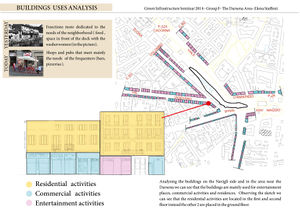
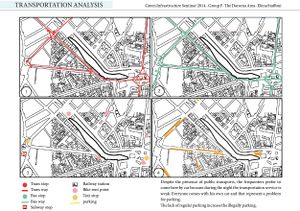
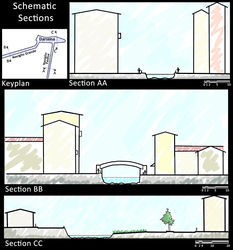
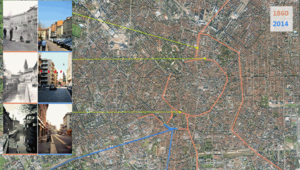

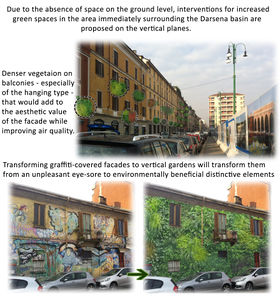
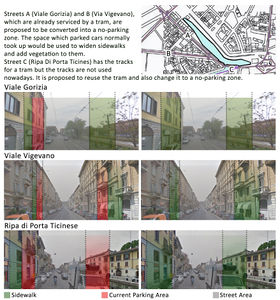
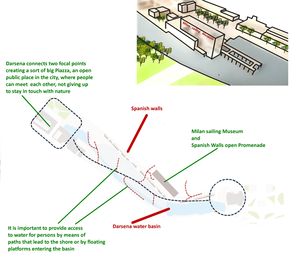
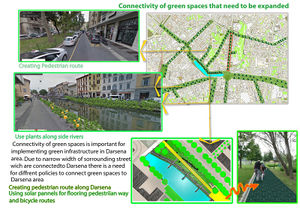
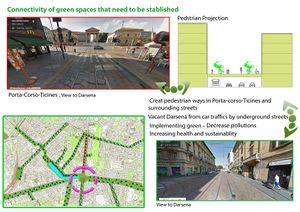
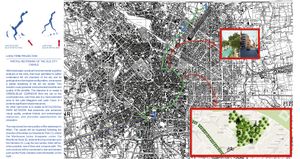
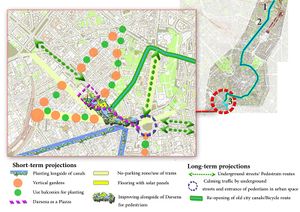
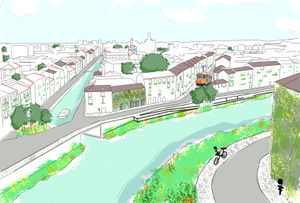
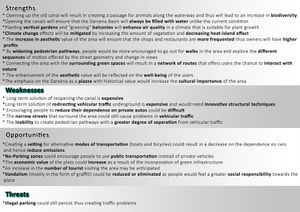
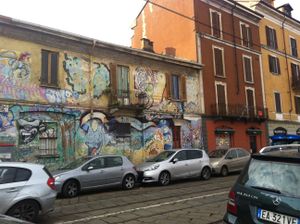

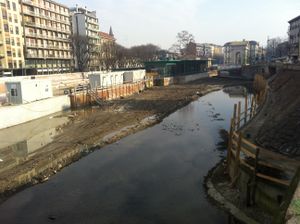
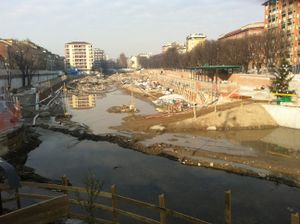
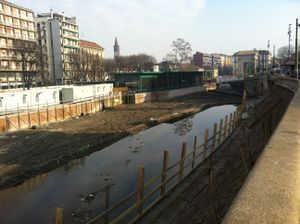
![A. Inganni (1835) Milano, a City Water [14]](/images/thumb/9/94/Navigli_Paint.png/300px-Navigli_Paint.png)
![I.Karpoff, Naviglio d'Inverno [15]](/images/thumb/4/47/Artgate_Fondazione_Cariplo_-_Karpoff_Ivan%2C_Naviglio_d%27inverno.jpg/300px-Artgate_Fondazione_Cariplo_-_Karpoff_Ivan%2C_Naviglio_d%27inverno.jpg)
![Canals covering [16]](/images/thumb/9/9f/Navigli_copertura_01.jpg/300px-Navigli_copertura_01.jpg)
![Boat tour at the end of XIX Century [17]](/images/thumb/8/8f/1280px-Navigli_di_Milano_Naviglio_Grande03.jpg/300px-1280px-Navigli_di_Milano_Naviglio_Grande03.jpg)
![Summer Aperitivo on Navigli side [18]](/images/thumb/b/b2/Navigli-10.jpg/300px-Navigli-10.jpg)
![Naviglio Grande [19]](/images/thumb/a/a8/Naviglio-grande-canal.jpg/300px-Naviglio-grande-canal.jpg)
![Naviglio Grande evening [20]](/images/thumb/e/e3/Naviglio_Grande_am_Abend.jpg/300px-Naviglio_Grande_am_Abend.jpg)
![Graffiti on a building in the Darsena area [21]](/images/0/04/Index.jpeg)
![sunday flea markt [22]](/images/thumb/a/a5/Mercatino.jpg/187px-Mercatino.jpg)
![Naviglio Martesana [23]](/images/thumb/d/d0/Martesana.jpeg/300px-Martesana.jpeg)
![The Naviglio Grande in Gaggiano town [24]](/images/thumb/7/70/Gaggiano.jpg/300px-Gaggiano.jpg)
![Swimming competition in Naviglio Grande [25]](/images/thumb/0/0b/Nuoto_triathlon_friesian_team_twitter-2.jpg/300px-Nuoto_triathlon_friesian_team_twitter-2.jpg)
![The oldest representation of the city (XIV Century) [26]](/images/thumb/3/39/Antica.jpg/250px-Antica.jpg)
![Green area system map of the Milan province [27]](/images/thumb/3/36/Provincia_plis_2006_p.gif/300px-Provincia_plis_2006_p.gif)
![Lombardy waterways [28]](/images/thumb/4/4a/LombardySimple.jpg/230px-LombardySimple.jpg)
![Waterways map for the EXPO 2015 [29]](/images/thumb/c/cb/Mappa_fluviale.jpg/300px-Mappa_fluviale.jpg)